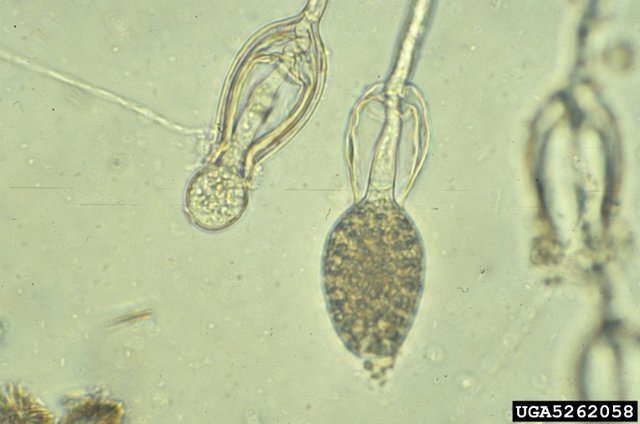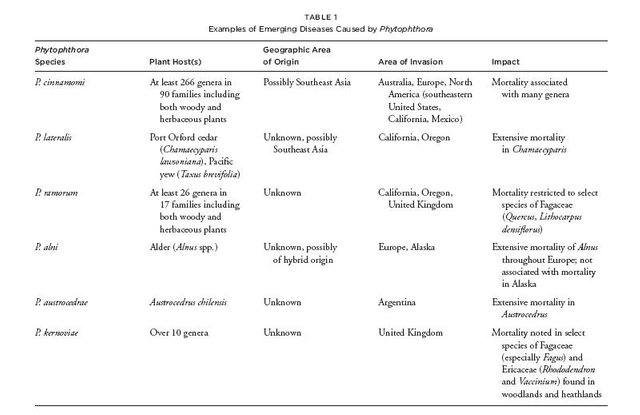TIL - Phytophthora is a genus of approximately 100 species of fungal-like, plant pathogenic organisms
Often known as “water molds”, Phytophthora is a genus of approximately 100 species of fungal-like, plant pathogenic organisms classified in the kingdom Stramenopila.
A number of Phytophthora species have been introduced into natural ecosystems around the world, sometimes with important ecological consequences,
They became one of the most important causes of emerging diseases in both agricultural and native plant communities. However, the ecology of Phytophthora invasions often differs between the two types of ecosystems.
In pathogen invasion of agroecosystems, plants are often reunited with pathogens with which they coevolved, and epidemics may result if the host–pathogen system is brought back together in a new geographic place, where it has been introduced. As an example, we have the Irish potato famine of the 1840s, caused by P. infestans. This Phytophthora species, probably natural from the southern Mexico, infects native species of potatoes without, causing major epidemics. But in Europe, it causes the potato disease commonly known as potato blight, which ravaged potato crops during the 1840s, with disproportionate impact in Ireland. The costs of these agricultural epidemics have been very high, every year billions of dollars are spent to combat Phytophthora diseases through the use of fungicides, resistant plants, and other horticultural practices.
On the other side, introduced invasive Phytophthora species into native plant communities, usually do not share a coevolutionary history. In this situation, hosts show often high susceptibility to infection. They can infect roots, stems, leaves, flowers, or fruits of susceptible plants and cause dieback, decline, or death.
Some of Phytophthora species are generalists, like Phytophthora cinnamomi

Phytophthora root rot by Phytophthora cinnamomi
Source: Florida Division of Plant Industry , Florida Department of Agriculture and Consumer Services, Bugwood.org
Others are specialists (infecting only one or a few plant species).

Emerging diseases caused by Phytophthora spp.
Source: Simberloff, D. & Rejmanek, M. (2011). Encyclopedia of biological invasions. Berkeley, CA: University of California Press, p 544
Phytophthora cinnamomi
This fungus-like organism is a soil-borne pathogen that infects woody plant hosts in many parts of the world. Infections on the roots leads to chronic decline or death of the plant, with earlier visible symptoms: wilting, yellowing and retention of dried foliage and/or bleeding cankers on trunks.
When infected, the plant is unable to adequately absorb enough water from the soil because its roots are damaged.
This pathogen has been introduced into native plant communities in Australia, North America, and Europe, however, extensive mortality appears to be restricted to oak and tanoak.
- Australia - The most susceptible species are members of the families Proteaceae, Ericaceae, Fabaceae, Xanthorrhoeaceaand Dilleniaceae, some of which are structurally important in vegetation communities;
- North America - Appears less devastating than in Australia. One of the most susceptible and severely affected hosts is the American chestnut (Castanea dentata). It is also reported to cause patches of mortality in stands of the rare plant Ione manzanita (Arctostaphylos myrtifolia) in California, and in the decline of white oak (Quercus alba);
- Europe - Problematic on Southern Europe, it attacks native chestnut trees (Castanea sativa) in Portugal, Spain, and France, also spreading to the chestnut areas of Italy. Combined with prolonged periods of intense drought is also contributing to oak decline in these countries.
If you're interested you can see more valuable info on GLOBAL INVASIVE SPECIES DATABASE
P.S. Special thanks to @haphazard-hstead, this post was the result of an interesting comment-reply conversation with her. Love this kind of relation on Steemit.
very interesting post - now I know the why when I see damaged trees, plants.....again, like I keep saying....plant native to your geographical location.....
Thanks! I'm also on your native plant team! Probably there are other harmful species from other genus, but I got curious on this Phytophthora cinnamomi that harms our native oaks in the US and Portugal (Mediterranean countries).
Nice post! These are some of the most frustrating organisms around, for sure. The P. lateralis in your list is really causing a lot of problems for Oregon's Port Orford Cedars. There are now lots of rules for hiking, driving, and camping in the areas with Port Orford Cedar trees.
Thanks for the shout-out, too!
As we had talk bout this on last week, I thought you would also like to know a bit more about Phytophthora sp.
Absolutely! There is so much to learn about them. The more we know, the more we can do to spread them around. It's interesting to me that the same species are affected on our US West Coast and in Portugal -- the poor oaks!